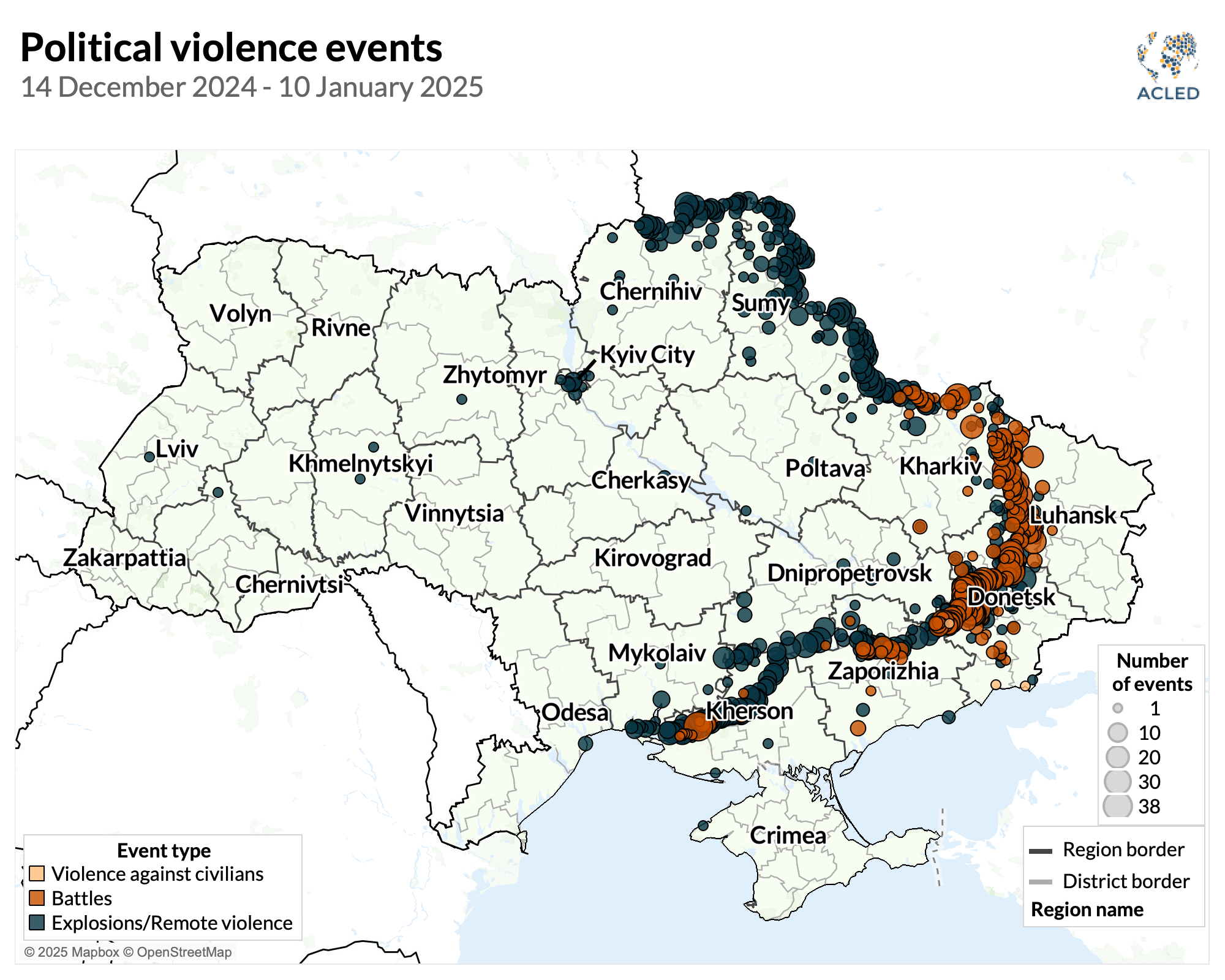Key trends
- In the Donetsk region, Russian forces occupied 10 settlements in the direction of Pokrovsk and seven others in the Kurakhove area, establishing full control over the town of Kurakhove. Russian forces also took over Storozheve near Velyka Novosilka and Ivanivka northeast of Lyman.
- Russian forces seized Lozova and Nadiia along the administrative border between the Kharkiv and Luhansk regions.
- ACLED records 58 Russian long-range missile and drone strikes, including in the city of Kyiv and the western regions of Ivano-Frankivsk, Khmelnytskyi, and Zhytomyr. Ukrainian forces intercepted strikes in at least 89 other instances, including over the western regions of Zhytomyr, Vinnytsia, and Khmelnytskyi.
- Russian shelling, missiles, and drones killed at least 71 civilians in the Zaporizhia, Kherson, Donetsk, Kharkiv, Dnipropetrovsk, Sumy, and Chernihiv regions and in the city of Kyiv. Another three civilians were killed during Russian airstrikes on Ukrainian positions in Stepnohirsk, Zaporizhia, and Antonivka, Kherson. A Ukrainian drone killed one and injured five others during a strike on a car transporting Russian journalists near Donetsk.
Key events
- 14 Dec. | Dnipropetrovsk – An IED attack by suspected Russian special services kills one civilian and injures two police officers in Dnipro
- 8 Jan. | Zaporizhia – A Russian airstrike targeting an aircraft engine factory kills 13 civilians and injures 127 others
- 10 Jan. | Donetsk – Ukrainian forces strike a Russian command and control center, residential buildings in Svitlodarsk, killing three civilians and wounding six
Spotlight: Wave of arson attacks shocks Russia
During December and the first days of January, ACLED records a nearly six-times increase in attempted or successful property destruction targeting Russian banks, postal offices, and police stations, as well as other public infrastructure such as relay cabinets and locomotives.
That these attacks target non-military infrastructure marks a notable divergence from the anti-war arson attacks that targeted military enlistment centers and the railway infrastructure used for military transport after the launch of Russia’s full-scale invasion of Ukraine.1Media Zona, ‘The number of arson under the influence of fraudsters has reached 50 in the last 12 days; this is the largest wave,’ 24 December 2024 The scope, number, and fact that these recent attacks are undertaken by Russian citizens (mostly pensioners) responding to blackmail or promises of remuneration via messaging apps or over the phone makes attribution and determining the motivation of the attacks difficult. So far, Russian security services and Russia’s leading Sber bank attributed the recruitment of Russians to carry out arson attacks to Ukrainian scammers.2The Moscow Times, ‘Russian Police Arrest 44 Amid Wave of Arson Attacks,’ 26 December 2024 While the Ukrainian government forces did not claim the attacks, the psychological effect of such a large wave of property destruction targeting public infrastructure raises the question of the involvement of Kyiv’s special services3The Economist, ‘Russia is being set aflame by hundreds of arson attacks,’ 12 January 2025 to mirror Russia’s targeting of public infrastructure in Ukraine.
Explore the ACLED Conflict Exposure tool to assess the numbers of people affected by armed violence, disaggregated by locations, time period, and actors involved.





